audio Lexus IS F 2011 Owner's Manual
[x] Cancel search | Manufacturer: LEXUS, Model Year: 2011, Model line: IS F, Model: Lexus IS F 2011Pages: 529, PDF Size: 13.89 MB
Page 1 of 529

TABLE OF CONTENTS
IS F_EE
1
1Before drivingAdjusting and operating features such as door locks,
mirrors, and steering column.
2When drivingDriving, stopping and safe-driving information.
3Interior featuresAir conditioning and audio systems, as well as other in-
terior features for a comfortable driving experience.
4Maintenance and
careCleaning and protecting your vehicle, performing do-it-
yourself maintenance, and maintenance information.
5When trouble
arisesWhat to do if the vehicle needs to be towed, gets a flat
tire, or is involved in an accident.
6Vehicle specifica-
tionsDetailed vehicle information.
IndexAlphabetical listing of information contained in this
manual.
Page 2 of 529
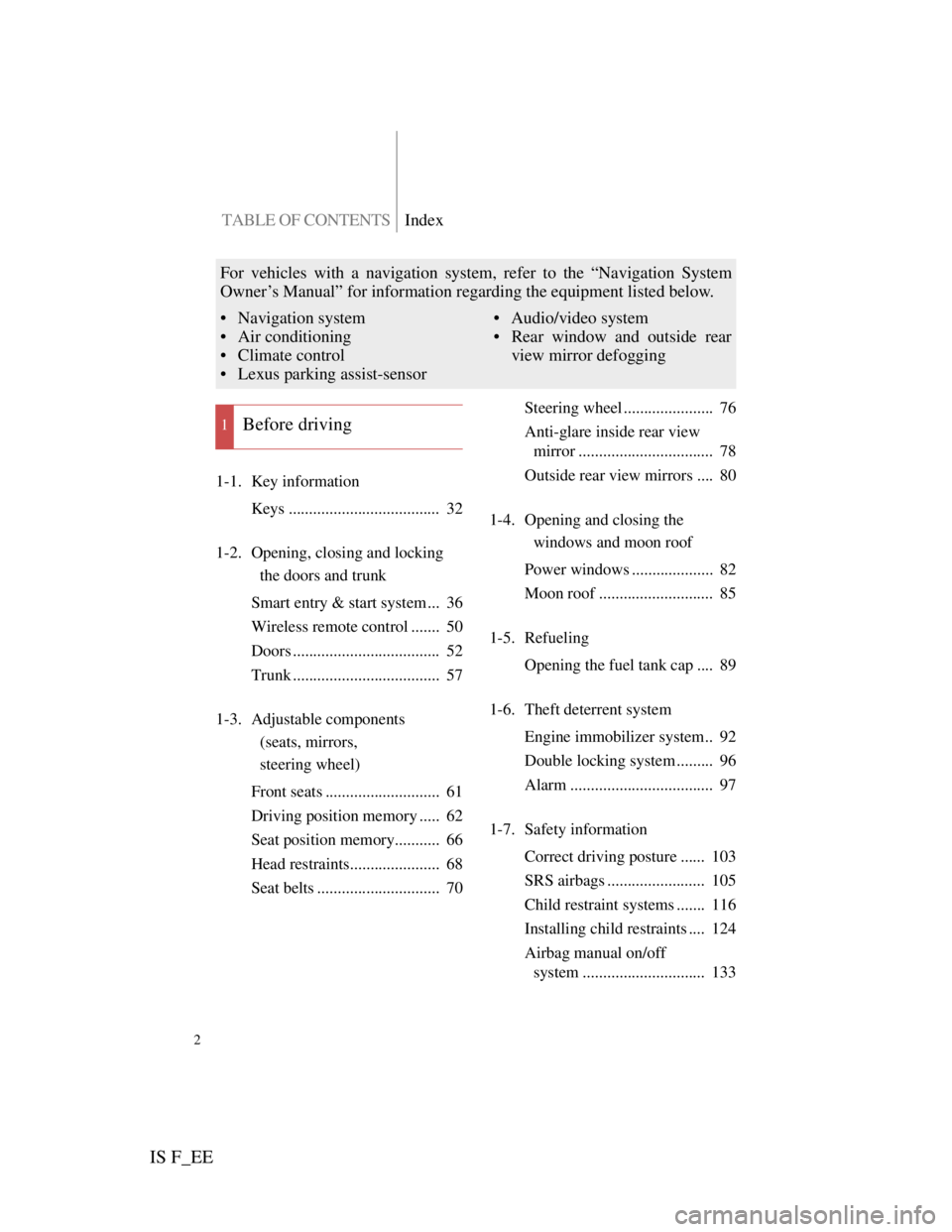
TABLE OF CONTENTSIndex
IS F_EE
2
1-1. Key information
Keys ..................................... 32
1-2. Opening, closing and locking
the doors and trunk
Smart entry & start system ... 36
Wireless remote control ....... 50
Doors .................................... 52
Trunk .................................... 57
1-3. Adjustable components
(seats, mirrors,
steering wheel)
Front seats ............................ 61
Driving position memory ..... 62
Seat position memory........... 66
Head restraints...................... 68
Seat belts .............................. 70Steering wheel ...................... 76
Anti-glare inside rear view
mirror ................................. 78
Outside rear view mirrors .... 80
1-4. Opening and closing the
windows and moon roof
Power windows .................... 82
Moon roof ............................ 85
1-5. Refueling
Opening the fuel tank cap .... 89
1-6. Theft deterrent system
Engine immobilizer system.. 92
Double locking system ......... 96
Alarm ................................... 97
1-7. Safety information
Correct driving posture ...... 103
SRS airbags ........................ 105
Child restraint systems ....... 116
Installing child restraints .... 124
Airbag manual on/off
system .............................. 133
1Before driving
For vehicles with a navigation system, refer to the “Navigation System
Owner’s Manual” for information regarding the equipment listed below.
• Navigation system
• Air conditioning
• Climate control
• Lexus parking assist-sensor• Audio/video system
• Rear window and outside rear
view mirror defogging
Page 4 of 529

TABLE OF CONTENTSIndex
IS F_EE
4
3-2. Using the audio system
Audio system types ............ 238
Using the radio ................... 241
Using the CD player........... 245
Playing back MP3 and
WMA discs ...................... 252
Operating an iPod............... 259
Operating a USB memory .. 266
Optimal use of the audio
system .............................. 273
Using the AUX port ........... 275
Using the steering wheel
audio switches .................. 276
3-3. Using the Bluetooth
® audio
system
Bluetooth
® audio system ... 279
Using the Bluetooth
® audio
system .............................. 283
Operating a Bluetooth
®
enabled portable player .... 286
Setting up a Bluetooth
®
enabled portable player .... 289
Bluetooth
® audio system
setup ................................. 2923-4. Using the hands-free phone
system (for mobile phones)
Hands-free system for
mobile phones .................. 293
Using the hands-free system
(for mobile phones) .......... 299
Making a phone call ........... 305
Setting a mobile phone ....... 309
Security and system setup .. 312
Using the phone book ........ 316
3-5. Using the interior lights
Interior lights list ................ 320
• Interior lights.................... 322
• Personal lights .................. 323
3-6. Using the storage features
List of storage features ....... 324
• Glove box ......................... 325
• Console box ..................... 326
• Cup holders ...................... 327
• Bottle holders/door
pockets ............................. 328
• Auxiliary box ................... 329
Page 15 of 529
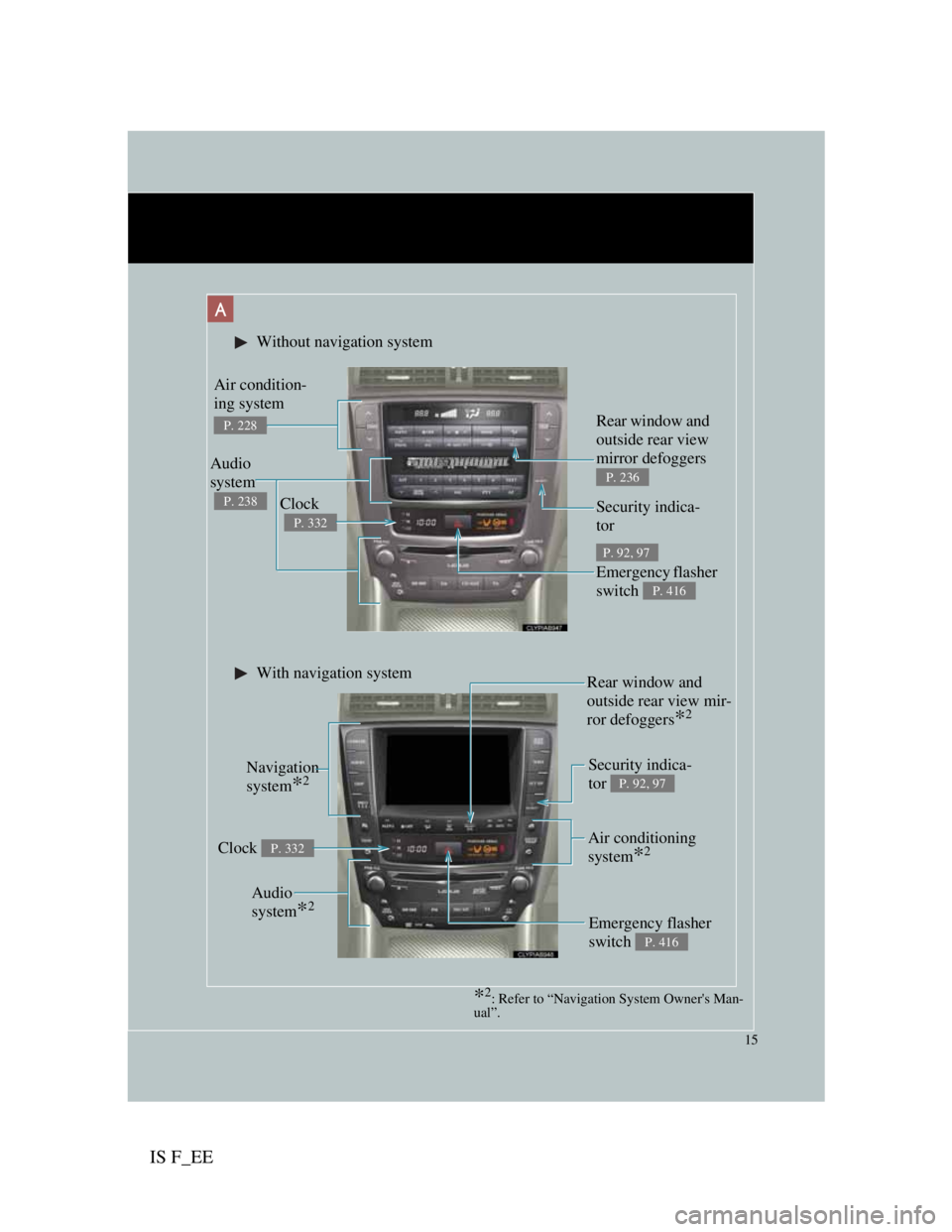
IS F_EE
15
Audio
system
*2
Without navigation system
Navigation
system
*2
Clock
P. 332
Audio
system
P. 238
Air condition-
ing system
P. 228Rear window and
outside rear view
mirror defoggers
P. 236
Security indica-
tor
P. 92, 97
Emergency flasher
switch
P. 416
Clock P. 332
Security indica-
tor
P. 92, 97
Rear window and
outside rear view mir-
ror defoggers
*2
Emergency flasher
switch
P. 416
Air conditioning
system
*2
With navigation system
A
*2: Refer to “Navigation System Owner's Man-
ual”.
Page 16 of 529
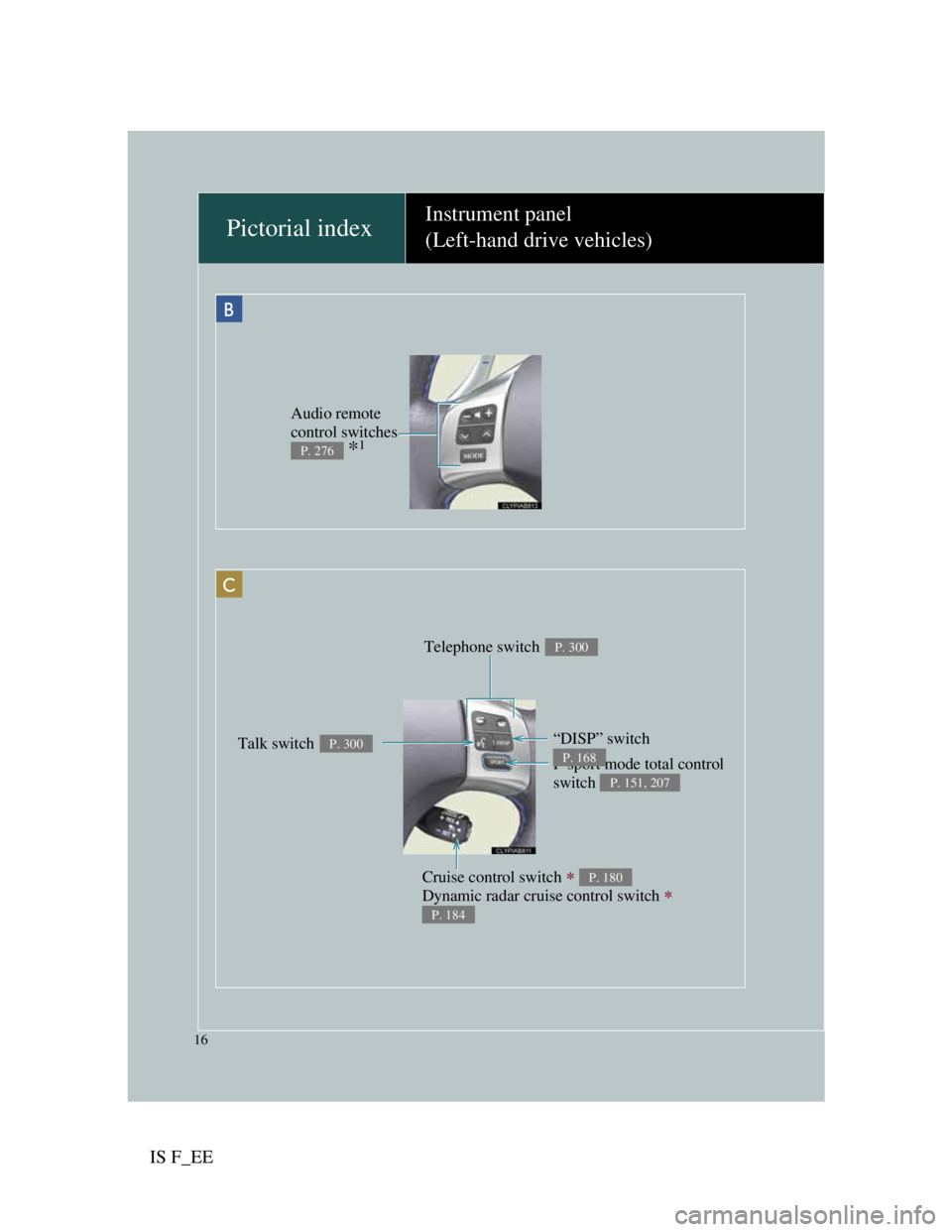
IS F_EE
16
Pictorial indexInstrument panel
(Left-hand drive vehicles)
Telephone switch P. 300
Cruise control switch
Dynamic radar cruise control switch
P. 180
P. 184
F-sport mode total control
switch
P. 151, 207
“DISP” switch
P. 168Talk switch P. 300
C
B
Audio remote
control switches
*1P. 276
Page 23 of 529
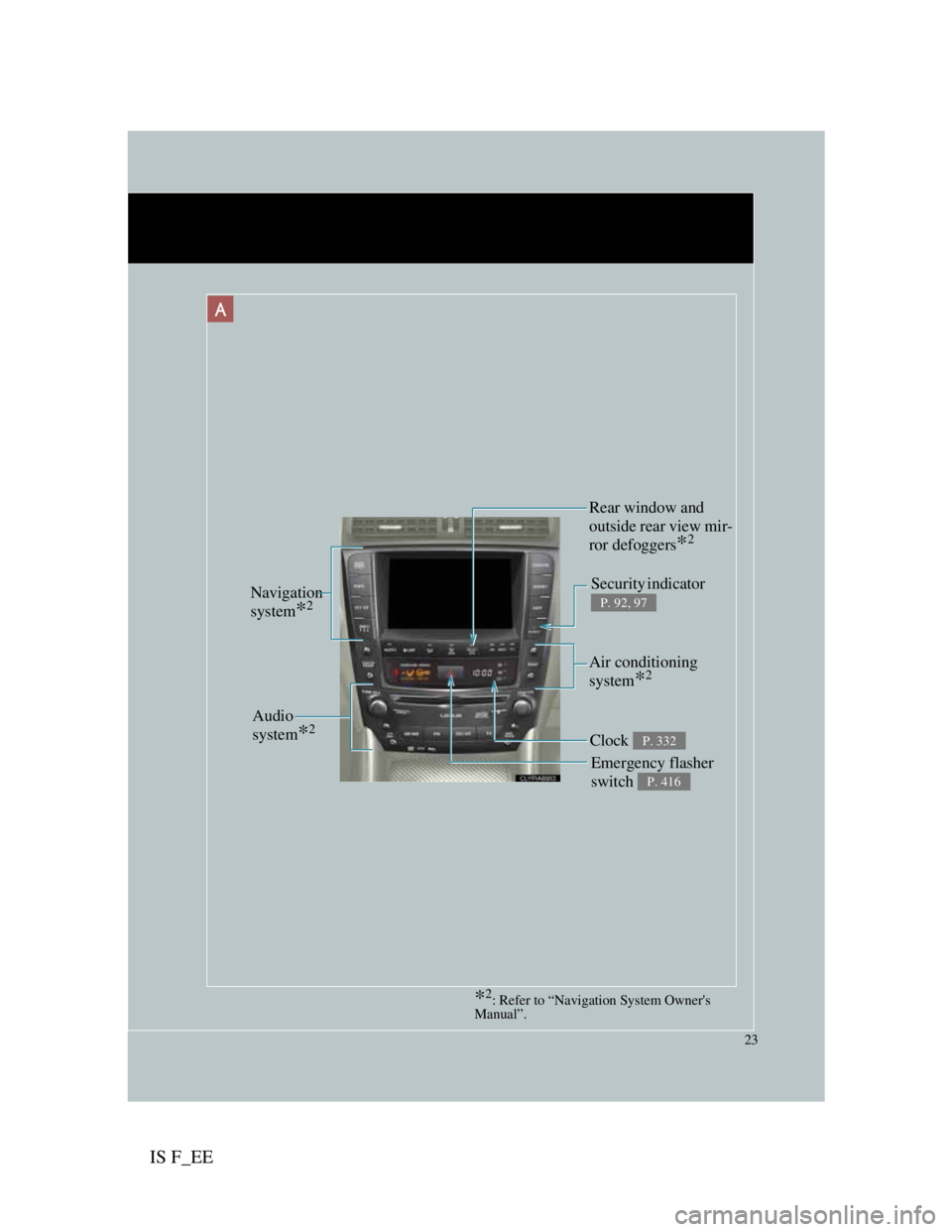
IS F_EE
23
Navigation
system
*2
Clock P. 332
Audio
system
*2
Security indicator
P. 92, 97
Emergency flasher
switch
P. 416
Air conditioning
system
*2
Rear window and
outside rear view mir-
ror defoggers
*2
A
*2: Refer to “Navigation System Owner's
Manual”.
Page 24 of 529
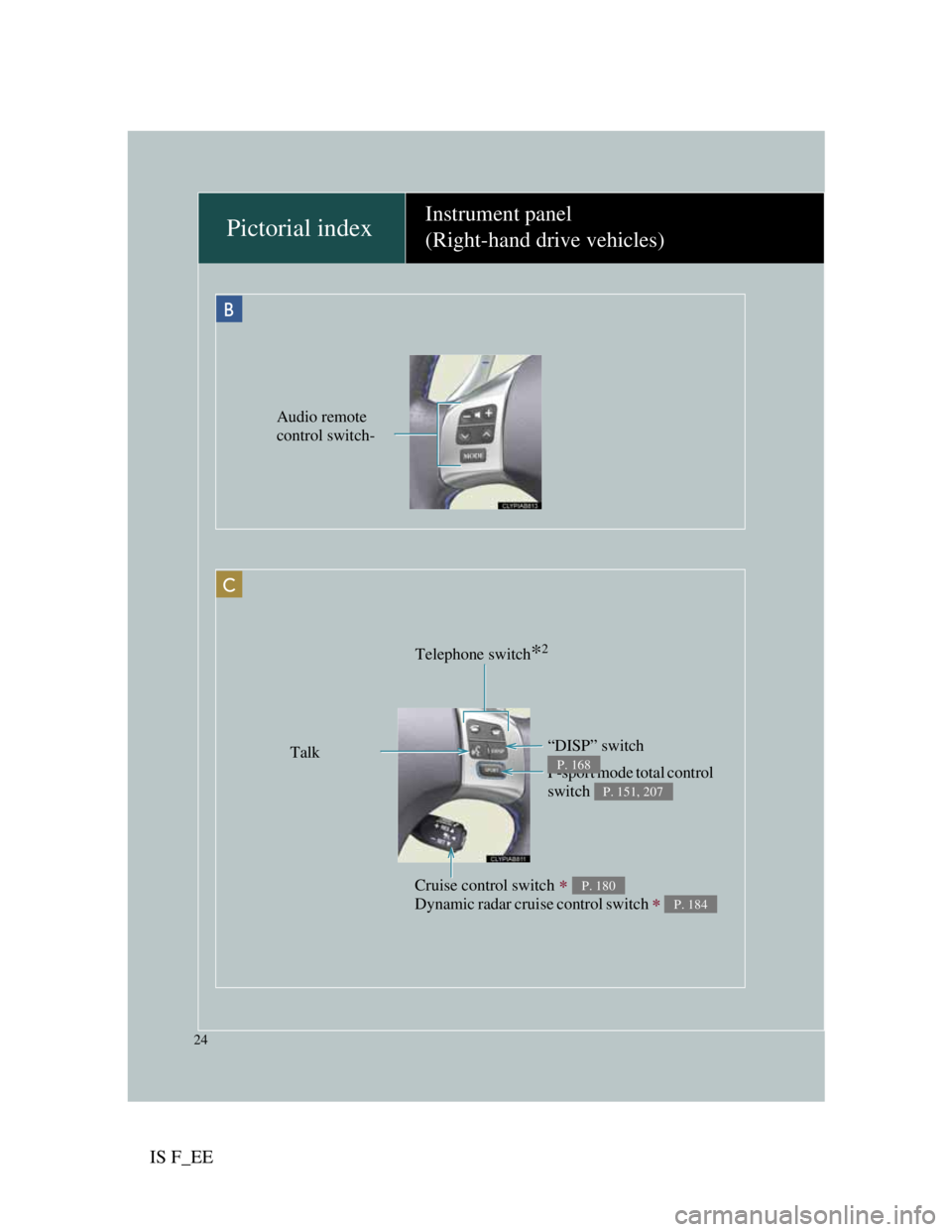
IS F_EE
24
Pictorial indexInstrument panel
(Right-hand drive vehicles)
Telephone switch*2
Cruise control switch
Dynamic radar cruise control switch
P. 180
P. 184
F-sport mode total control
switch
P. 151, 207
“DISP” switch
P. 168Talk
C
B
Audio remote
control switch-
Page 37 of 529

37
1-1. Key information
1
Before driving
IS F_EE
To prevent key damage
Observe the following:
Do not drop the keys, subject them to strong shocks or bend them.
Do not expose the keys to high temperatures for a long period of time.
Do not get the keys wet or wash them in an ultrasonic washer etc.
Do not attach metallic or magnetic materials to the keys or place the keys
close to such materials.
Do not disassemble the keys.
Do not place the keys near objects that produce magnetic fields, such as
TVs, audio systems, glass top ranges, or medical electrical equipment,
such as low-frequency therapy equipment.
Precautions for handling the card keys
Do not apply excess force when inserting the mechanical key to the card
key. Doing so may damage the card key.
If the battery or card key terminals get wet, the battery may corrode and
the card key may stop working.
If the key is dropped into water, or if drinking water etc. is spilled on the
key, immediately remove the battery cover and wipe the battery and ter-
minals. (To remove the battery cover, lightly grasp and pull it.) If the bat-
tery is corroded, have any authorized Lexus dealer or repairer, or another
duly qualified and equipped professional, replace the battery.
Do not crush the battery cover or use a screwdriver to remove the battery
cover. Forcibly removing the battery cover may bend or damage the key.
If the battery cover is frequently removed, the battery cover may become
loose.
When installing the battery, make sure to check the direction of the bat-
tery.
Installing the battery in the wrong direction may cause the battery to
deplete rapidly.
The surface of the card key may be damaged, or its coating may peel off
in the following situations.
• The card key is carried together with hard objects, such as coins or
keys.
• The card key is scraped with a sharp object, such as a tip of mechanical
pencil.
• The surface of the card key is wiped with thinners or benzene.
Page 44 of 529

41
1-2. Opening, closing and locking the doors and trunk
1
Before driving
IS F_EE
Operation signals
Doors: The emergency flashers flash to indicate that the doors have been
locked/unlocked. (Locked: Once; Unlocked: Twice)
Windows and moon roof: A buzzer sounds to indicate that the windows and
moon roof are operating.
Conditions affecting operation
The smart entry & start system uses weak radio waves. In the following sit-
uations, the communication between the electronic key and the vehicle may
be affected, preventing the smart entry & start system and wireless remote
control from operating properly:
(Ways of coping: P. 458)
When the electronic key battery is depleted
Near a TV tower, electric power plant, gas station, radio station, large
display, airport or other facility that generates strong radio waves or elec-
trical noise
When carrying a portable radio, cellular phone, cordless phone or other
wireless communication devices
When the electronic key is in contact with, or is covered by the follow-
ing metallic objects
• Cards to which aluminum foil is attached
• Cigarette boxes that have aluminum foil inside
• Metallic wallets or bags
• Coins
• Hand warmers made of metal
• Media such as CDs and DVDs
When multiple electronic keys are in the vicinity
When another wireless key (that emits radio waves) is being used nearby
When carrying or using the electronic key together with the following
devices that emit radio waves
• Another vehicle's electronic key or a wireless key that emits radio
waves
• Personal computer or personal digital assistant (PDA)
• Digital audio player
• Portable game system
If window tint with a metallic content or metallic objects are attached to
the rear window
Page 157 of 529

147
2-1. Driving procedures
2
When driving
IS F_EE
Changing “ENGINE START STOP” switch mode
Modes can be changed by pressing the “ENGINE START
STOP” switch with the brake pedal released. (The mode changes
each time the switch is pressed.)
OFF
*
The emergency flashers can
be used.
ACCESSORY mode
Some electrical components
such as the audio system can
be used.
The “ENGINE START
STOP” switch indicator turns
amber.
IGNITION ON mode
All electrical components can
be used.
The “ENGINE START
STOP” switch indicator turns
amber.
*:If the shift lever is in a posi-
tion other than P when turning
off the engine, the “ENGINE
START STOP” switch will be
d